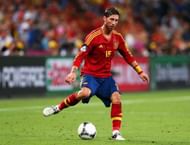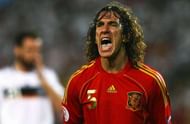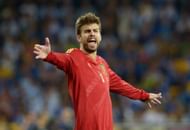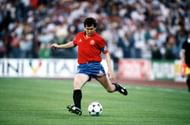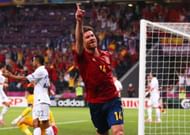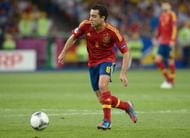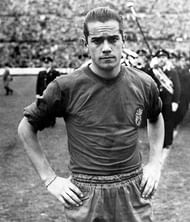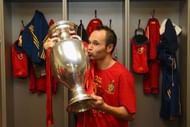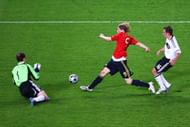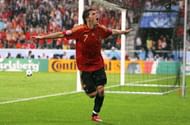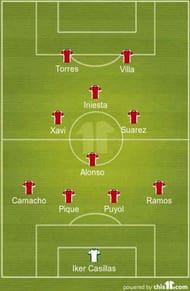So often derided for producing top class talent but failing at the final hurdle, the country of Spain was always looked at as a team with wonderful players, but lacking conviction and easy to defeat. Prior to the European Championships of 2008, they had won only a single international tournament, the Euros of 1964 which they hosted and finished runners-up in 1984 losing to a Platini-inspired France in the final.
The Spanish players had always experienced incredible success at club level but failed to succeed at the international stage. Fans started to think they will never get to witness their beloved La Roja lift a prestigious international title, until 2008.
Led by the golden generation of Barcelona and a strong Spanish core of Real Madrid, Spain didn’t just win but dominated the entire world winning the Euros of 2008 and the FIFA World Cup of 2010 before winning another European championship in 2012.
But the thing that captivated and made the world stand up and notice them was not their results, but how they went about achieving these results employing a style of passing and movement, simply called Tiki Taka.
Prior to the start of the European Championships of 2016, we take a look at the greatest XI of the defending champions, all the way from 1964 to the present.
Formation: 4-4-2 (Diamond)
Goalkeeper
Iker Casillas
The highest capped Spanish player ever (166) and the captain of the one of the greatest teams of all time, Iker Casillas has cemented himself in Spanish football history as the finest goalkeeper the country has ever seen. San Iker as he is fondly known by the supporters has found himself between the posts for well over a decade now, defending his country with class and aplomb.
His spectacular saves in the penalty shootout against Italy in the quarter-finals of the 2008 tournament led the team to the final, eventually defeating Germany. His leadership also saw the team win a second Euro on the trot in 2012.
Having come through the ranks of one of the European powerhouses in Real Madrid, Casillas has become a fan favorite and remains an icon. With age though, his reflexes and movement have diminished a bit and he is expected to be replaced by David De Gea as the starter for Euro 2016.
Nevertheless, he will always remain an incredible influence, one who was at the forefront of the ‘golden generation’ of Spanish football.
Defenders
Right Back: Sergio Ramos
Sergio Ramos has become an incredible force in the last few years, playing a major role in Spain’s triumphs at Euro 2008 and Euro 2012. Starting his career as a right-back, the defender has gone from strength to strength, transforming himself into one of the best centre-backs in the world today.
He has improved on his earlier weaknesses such as discipline, and has become a senior member of the Spanish squad, having already amassed 133 caps for La Roja at just 30 years of age. He has proven his abilities at club level as well, playing an integral part in Real Madrid’s two Champions League titles in the past three years.
Possessing world class aerial ability as well as a passionate persona, the player could become the next captain of the side. He is starting at right-back in the XI.
Centre-Back: Carles Puyol
The heart of Spain’s defense from his debut in 2000 to his retirement in 2013, the centre-back has amassed 100 caps for the national side. Another extremely passionate character with great tactical and positional sense, he was also at the heart of FC Barcelona’s dominance in the past decade.
Puyol's presence in the middle itself instilled fear in the hearts of opponents. His partnership with Carlos Marchena in defense allowed Spain to form a rock solid unit, conceding just two goals in the entire 2008 tournament en route to the title.
He was included in the team of the tournament for his heroics. His versatility meant he could play on either flank as well, but found most success as a centre-back. A product of Barcelona’s youth academy La Masia, he is regarded as one of the greatest defenders of this generation.
Centre-back: Gerard Pique
Another of La Masia’s products, Gerard Pique has established himself as an integral part of the Spanish back-line since the FIFA World Cup in 2010, with 75 appearances to date. Playing in Euro 2012, the Spaniard was included in the team of the tournament as his partnership with Sergio Ramos allowed Spain to comfortably win the final 4-1 against Italy.
Starting his professional career at Manchester United before returning to his beloved Barcelona, Pique has proved himself as a fine defender, leading the Blaugrana to a trophy-laden spell. His partnership with Puyol in the early years was regarded as one of the best in Spain’s illustrious history. The centre-back is expected to start in Euro 2016 as well.
Left Back: Jose Antonio Camacho
Regarded as one of the finest left-backs, Jose Antonio Camacho represented La Roja in two World Cups as well as two European Championships, making 81 appearances in total. However, the incredible success he achieved at club level with Real Madrid never translated into international accolades as the closest Spain came to a title during his career was their run to the final at the Euro 1984 in France.
Camacho though is a highly respected figure in Spanish football, having coached the national team from 1998 to 2002. He makes the cut as the left-back for this team.
Midfielders
Defensive Midfield: Xabi Alonso
There could only be one choice for the defensive midfield position. Xabi Alonso has established himself as the most suitable to sit back and allow the attacking midfielders to move forward. Mainly playing as a deep-lying playmaker, the player is also capable of putting in the miles defensively helping his team out, acting as the second line of defense.
He is also known for his vast range of passing, being adept at set-pieces as well as a penalty specialist. He is known for his industrious work ethic and has been extremely important for Spain, making his debut in 2003 and going on to amass 114 caps, taking part in three European Championships (2004, 2008 and 2012) and three World Cups (2006, 2010 and 2014) before retiring in August 2014.
For his overall performance, he was rewarded with a spot in the UEFA Team of the tournament for the 2012 edition and remains a force at club level, having played for giants like Liverpool, Real Madrid and currently thriving in Germany with Bundesliga champions Bayern Munich.
Left midfield: Xavi Hernandez
The pivot, the axis, the fulcrum on which the entire Tiki Taka philosophy of Spain and Barcelona functioned, Xavi Hernandez is arguably the greatest midfielder in the history of Spanish football. Second to only Casillas in appearances made with 133, his presence in the middle itself, with his incredible vision and passing ability, has led Spain to dizzying heights.
A product of the famed La Masia, he is often hailed as the most influential player in the team, earning the sobriquet “The Puppet Master” for pulling the strings and making the team tick. He was named the Best player of the tournament at UEFA Euro 2008 after being named in the team of the tournament.
In 2012, he was once again named in the team of the tournament and became the only player to register assists in two consecutive European Championship finals, setting up the only goal in the 2008 showpiece and two more in the 2012 final. Undoubtedly, the backbone of Spain’s glory years.
Right Midfield: Luis Suarez
Before the Uruguayan, there was a Spanish Luis Suarez, arguably as important as the current one for the Blaugrana in the 1950s. Regarded as one of the legendary Spanish players, Suarez, nicknamed “the Architect” dictated play from the middle.
Possessing a style of play pleasing to the eye, he prospered as an attacking midfielder in his earlier days at Barcelona before moving on to slot in as a deep-lying playmaker for Helenio Herrera's incredibly successful Grande Inter side of the 1960s. He became the first ever Spanish-born player to win the Ballon d’Or in 1960 and led the then Spanish team to their first international title, the Euro 1964, being included in the team of the tournament as well.
His vision and passing prowess, as well as a keen eye for goal were qualities that made him stand out from the rest of the team. His creativity with the ball at his feet cemented his place as one of the all-time greats.
Attacking Midfield: Andres Iniesta
Yet another of La Masia’s graduates, Andres Iniesta is known as the best playmaker in the world even today. His consistency, his skill level and his creative ability since his young days as a kid, coming through the ranks at Barcelona are unrivaled to this day.
Since his international debut in 2006, the Spaniard has gone on to make 107 appearances for La Roja, playing an important part in securing the two European Championships and the World Cup, scoring a dramatic goal in extra time to win the latter.
Known to be a big match player, Iniesta has always come up with the goods whenever required be it at club level or internationally, scoring or assisting crucial goals. He is to date the most decorated Spanish footballer in history surpassing his midfield partner Xavi with 30 trophies.
Having been selected in the Team of the tournament in the 2008 and 2012 Euro editions as well as being named the best player at the 2012 tournament, Iniesta has firmly established himself as a Spanish legend.
He has also been awarded the UEFA Best player in Europe in 2012 beating stalwarts like Lionel Messi and Cristiano Ronaldo. He also finished runner-up to the Argentine in the 2010 Ballon d’Or race, going to show just how highly he is regarded in the world of football.
Forwards
Left Striker: Fernando Torres
The first striker position and none other than Fernando Torres lines up for this team. Even though the forward has been in indifferent form for the past few years, when it comes to performing for the national side, he is always back to his breathtaking best. Having represented La Roja since 2003, the Spaniard has amassed 107 caps, winning two European Championships and the FIFA World Cup as well.
The importance of the 32-year-old can never be understated as he scored the only goal in the final of the 2008 final to win Spain its first international title since 1964 and made the team of the tournament as well. He also scored in the final of the 2012 edition and is his country’s third highest goal-scorer with 38 goals.
Torres has always delivered for La Roja but sadly will not be taking part in the 2016 edition as Vicente del Bosque has preferred to leave the striker out for other forwards like Morata and Nolito. El Nino though will always remain in the hearts of the fans as the player who brought Spain's title drought to an end.
Right Striker: David Villa
Who else but David Villa to round it off. El Guaje is Spain’s all-time top goal-scorer with an incredible 59 goals in just 97 appearances. Since making his debut in 2005 till his retirement after the 2014 World Cup, Villa developed into one of the most feared strikers in the world.
Possessing world class technique and finishing ability, Villa succeeded legendary striker Raul as La Roja’s no.7 with great success. He finished as top scorer of Euro 2008 as well as the World Cup in 2010, both of which Spain won, proving his worth to the team.
His exploits saw him make the cut for the team of the tournament in 2008 and having played a major role in the qualifying campaign for the 2012 edition, Villa was unlucky to miss out as a fractured tibia kept him out of the tournament Spain went on to win. A striker of the highest quality, Spain still haven’t found an able replacement for his goal-scoring prowess.

